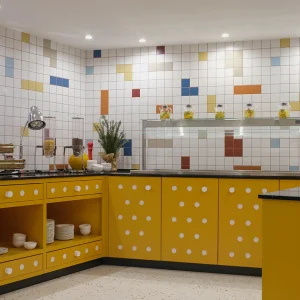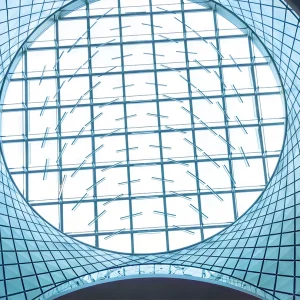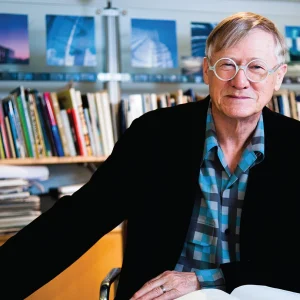
Case study 1
City Information System, Bath
How do you remodel the streets and public spaces of a heritage city like Bath? This was the challenge posed to design studio PearsonLloyd, when it was asked to design the city’s wayfinding system, bus shelters and street furniture. It proved to be a tough assignment: Bath’s preservation lobby – and a vocal group of protective residents – have a tendency to view changes made to the city as an act of cultural vandalism.
To develop a contemporary design aesthetic that would sit harmoniously in the city and appease the opposition, PearsonLloyd looked to the geometric forms of the city’s predominantly 18thcentury architecture; particularly its grid of broad streets and renowned Palladian buildings, squares and crescents. The studio also drew on Bath’s status as a model city of the Age of Enlightenment, and the scientific instruments associated with this period.
The studio proposed a circular, vitreous enamel map, referencing the compass, lens and sundial. The map is set in a rectangular bronze monolith. This bold, geometric aesthetic is shared by the studio’s bus shelter designs, composed of a series of bronze blocks. Collectively the creations have a powerful, modern presence in Bath’s streetscape, all the while referencing the typology of the surrounding architecture.

The sundial-type map inset is created in vitreous enamel
The materials selected for this major overhaul of Bath’s street furniture is almost entirely traditional in nature, with bronze for the signs, and timber and metalwork for benches. Luke Pearson, co-founder of the studio, says: ‘There’s quite often a sense that there are lots of new materials out there. While that can be true – and can be one of the most exciting aspects of product development at the moment – the reality is that they are often too expensive or exotic for common use.’
He adds that the big design challenge is often in how to get the best use of some of the standard materials, and adapting them to individual industry’s requirements. In airlines for example, he says the key criteria to consider are fire, weight and longevity, and probably in that order, while in other sectors it may be more about tactility.
Pearson adds: ‘For the Bath project, we wanted to find a material that had an inherent quality and timelessness, but also was low maintenance.
‘We relish the fact that a certain project might require a particular material and almost force our hand as designers. Our world is primarily based around fairly standard materials – wood, metal, glass and plastic – and although there are of course more exotic versions of each you usually have to have an exceptionally good reason to use the more expensive kinds.’
Case study 2
Sky TV HQ, London
The new and Starship Enterprise-esque reception area of Sky TV’s London HQ is a perfect match for the BSkyB brief, which asked for a feature centrepiece that was modern, futuristic and complementary to the light and spacious reception area. Architecture practice Head Roberts & Associates, worked in collaboration with BSkyB’s own creative team that produced the conceptual design for the desk. Head Roberts then produced detailed drawings and specified all the surfaces and materials, including Hi-Macs for the centerpiece reception desk.

Thermoformed into a spectacular concave form, with a sweeping translucent inset centre panel in Perspex, the dramatic effect is enhanced by LED back lighting. The suspended ceiling, mirroring the space-age shape of the desk below, has strategic downlighting at its centre, an inverted dome featuring LED lighting with a colour spectrum of pink, blue, purple and yellow.

To mark out the reception area and the wider open-plan office, the larger area was finished with a rich, modernistic carpet, while the approach to and surround of the reception area is covered with a highly reflective glossy rubber sheet surface, Noraplan Uni.
Architect:
Fabricator:
Case study 3
Best Western Premier Elysée Secret Hotel, Paris
In the middle of the Champs-Elysées Quarter in Paris, the Best Western Premier Elysée Secret hotel features an engaging design concept inspired by the boudoir of Marie Antoinette. Based on a design from the Parisian architecture firm Axel Schönert Architectes Associés, this establisehd hotel was completely renovated – and a sophisticated 4-star hotel emerged.
It was a particular challenge to transform this six-storey hotel was approximately 600 sq m because of its comparatively small size. ‘Our goal was to make the best use of the available space while creating a unique atmosphere,’ explains interior designer Zsofia Varnagy. ‘In this lively metropolis, we wanted to create a place to retreat to, where one can dream and enjoy life.’

The ‘lady of the house’ is encountered by the guests throughout the entire hotel. Four key spheres of colour can be found throughout the building Photo credit: Luc Boegly / Architecture Axel Schoenert Architectes Associés
During the eight-month planning phase a design concept emerged that was based on the Marie Antoinette style, but with a modern interpretation. The ‘lady of the house’ meets her guests throughout the entire hotel: as a silent companion in the elevator, on the walls and doors, in the wardrobe, on cosmetic items – she even appears on the profile of bedside tables.
In the design of the interior, the architects were able to achieve a harmonious combination of baroque elements and modern-day accents. Four key colours are found throughout the building and distinguish the boutique hotel’s 26 guest rooms. Wall sections, cabinet panelling and distinctive fabrics are presented in bright fuchsia, warm yellow gold, elegant green or fresh lilac.

The highlight of the interior is the furniture designed specifically for the hotel and made of Hi-Macs solid surface Photo credit: Luc Boegly / Architecture Axel Schoenert Architectes Associés
Perhaps the highlight of the interior is the furniture, custom designed for the hotel and made of solid surface material Hi-Macs. ‘It makes room for excellent 3D creations and is perfectly suited for use in hotels,’ says Axel Schoenert. Not only the sculptured reception counter, but also the unusual bedside tables and – depending on the size of the room – the individually planned bureaus and washbasins are made of the solid-surface material in the colour Alpine White.
The architects brought in solid surface specialist fabricator Rosskopf + Partner, responsible for the construction planning and production as well as the logistics and assembly on-site.

In the first step, Rosskopf + Partner’s material and processing experts subjected Varnagy’s designs to a detailed feasibility study and costing. Four weeks later, the project team of experienced engineers and craftspeople completed to fabrication the entire series of furniture using Hi-Macs solid-surface material at the company’s facility in Hennersdorf, Saxony.
Architect:
Architecture Axel Schoenert Architectes Associés
Fabricator:





